Description
The species has a shell height of 1.8 mm and a shell width of 1.2 mm. The shell is greatly variable, taller and slenderer than those of its relatives. It is smooth, transparent and has a conic shape with approximately 5 slightly shouldered whorls, sometimes with an obtuse keel. The opening (aperture) is taller than wide, visible in the shells of the northernmost cave (Pivnica špilja), but hardly pronounced in shells from its other known locality, Jama na Škrilama. The peristome is roundish to oval, with a straight or rounded parietal shield, which is well-differentiated from the lip. The parientalis is present in the opening with varying prominence. The shell has a parietalis and a weak columellaris. The columellaris is completely absent in some of the examined individuals. [1]

The Velebit mountains of Croatia have several deep caves with some of the world's largest subterranean vertical drops.
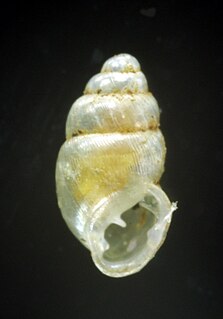
Carychiinae is a taxonomic subfamily of minute air-breathing land snails, terrestrial pulmonate gastropod mollusks.

Zospeum is a genus of air-breathing land snails, terrestrial pulmonate gastropod mollusks in the family Ellobiidae, the salt marsh snails.

Ellobiidae, common name the hollow-shelled snails, is a family of small air-breathing land snails, terrestrial pulmonate gastropod mollusks in the clade Eupulmonata. Ellobiidae is the only family in the superfamily Ellobioidea, according to the taxonomy of the Gastropoda by Bouchet & Rocroi, 2005).

Seashore wildlife habitats exist from the Tropics to the Arctic and Antarctic. Seashores and beaches provide varied habitats in different parts of the world, and even within the same beach. Phytoplankton is at the bottom of some food chains, while zooplankton and other organisms eat phytoplankton. Kelp is also autotrophic and at the bottom of many food chains. Coastal areas are stressed through rapid changes, for example due to tides.
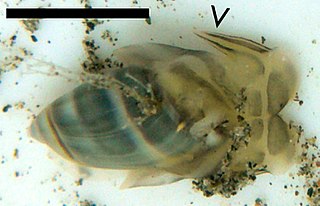
Olivella columellaris is a species of small sea snail, a marine gastropod mollusk in the family Olivellidae, the dwarf olives. With the very similar Olivella semistriata it forms the subgenus Pachyoliva. Both species are suspension feeders. They use unique appendages of the propodium to deploy mucus nets which capture suspended particles from the backwash on sandy beaches of the tropical eastern Pacific.

Olivella semistriata is a species of small sea snail, a marine gastropod mollusk in the family Olivellidae, the dwarf olives. With the very similar Olivella columellaris it forms the subgenus Pachyoliva. Both species are suspension feeders. They use unique appendages of the propodium to deploy mucus nets which capture suspended particles from the backwash on sandy beaches of the tropical eastern Pacific. Olivella semistriata is a swash-surfer; the snails use their expanded foot as an underwater sail to follow the tidal movement of the backwash zone in which they feed.

Inchoatia inchoata is a species of air-breathing land snail, a terrestrial pulmonate gastropod mollusc in the family Clausiliidae, the door snails.
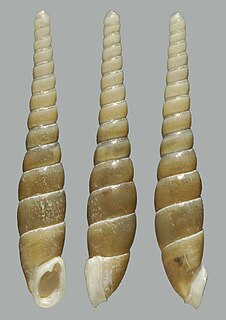
Leptacme cuongi is a species of air-breathing land snail, a terrestrial gastropod mollusk in the family Clausiliidae, the door snails.

Oospira smithi is a species of air-breathing land snail, a terrestrial gastropod mollusk in the family Clausiliidae, the door snails.
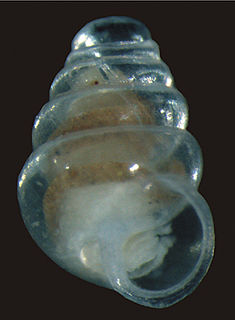
Zospeum tholussum or the Domed Land Snail, is a cave-dwelling species of air-breathing land snails in the family Ellobiidae. It is a very small species, with a shell height of less than 2 mm (0.08 in) and a shell width of around 1 mm (0.04 in). Z. tholussum individuals are completely blind and possess translucent shells with five to six whorls. The second whorl of their shells has a characteristic dome-like shape. They are also extremely slow-moving and may depend on passive transportation through running water or larger animals for dispersal.

Biospeleology, also known as cave biology, is a branch of biology dedicated to the study of organisms that live in caves and are collectively referred to as troglofauna.
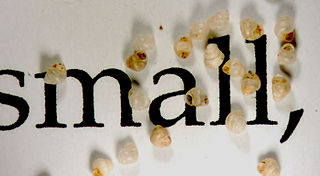
Acmella nana is a species of land snail discovered from Borneo, Malaysia, in 2015. It was described by Jaap J. Vermeulen of the JK Art and Science in Leiden, Thor-Seng Liew of the Institute for Tropical Biology and Conservation at the Universiti Malaysia Sabah, and Menno Schilthuizen of the Naturalis Biodiversity Center in Leiden. It was named nana due to its minute size. Measuring only 0.7 millimeters in size, it is the smallest known land snail as of 2015. It surpasses the earlier record attributed to Angustopila dominikae, which is 0.86 mm in size, described from China in September 2015.

Zospeum percostulatum is a species of air-breathing land snail, a terrestrial pulmonate gastropod mollusk in the family Ellobiidae, the salt marsh snails. This species is endemic to Asturias, Spain. It is known from several limestone caves near Llanes. Though there were a few old records of Zospeum in Asturias, dubiously identified as Z. suarezi and Z. schaufussi, Zospeum percostulatum is the first species described for this autonomous community.
Zospeum vasconicum is a cave-dwelling species of air-breathing land snails.
Koreozospeum is a genus of small air-breathing land snails. It contains a single species, Koreozospeum nodongense.
Zospeum zaldivarae is a cave-dwelling species of air-breathing land snail.
Zospeum robustum is a cave-dwelling species of air-breathing land snails.
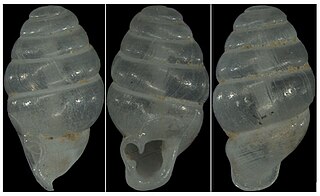
Laoennea renouardi is one of two species in the genus Laoennea of the Asian terrestrial snail family Diapheridae.
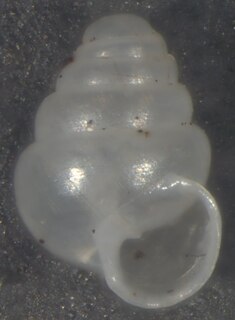
Zospeum manitaense is a cave-dwelling species of air-breathing land snail. Some individuals in this genus were previously described under the name of Zospeum amoenum, Zospeum isselianum or Zospeum pretneri.
This page is based on this
Wikipedia article Text is available under the
CC BY-SA 4.0 license; additional terms may apply.
Images, videos and audio are available under their respective licenses.















